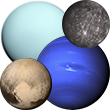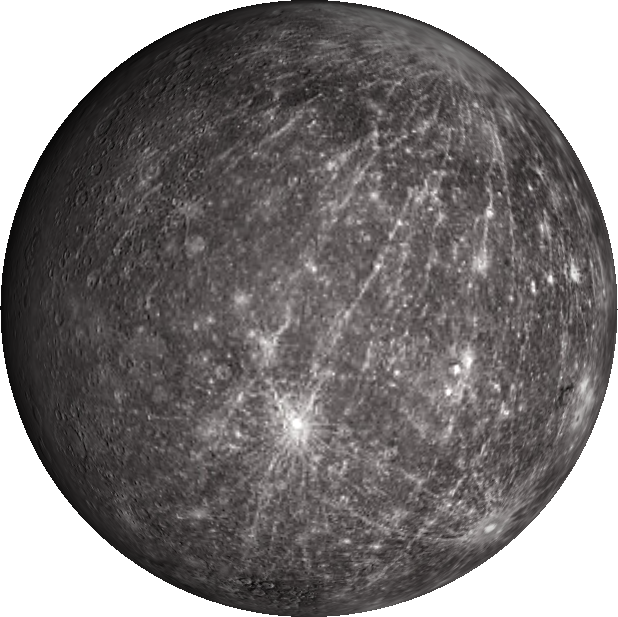Mercury is a mysterious planet. Here are some of the main Mercury mysteries.
-
- Mercury has water ice, that also seems to be not as old as would be expected
- Mercury's atmosphere changes with its distance from the Sun
- Apart from Earth, it is the only inner planet with a global magnetic field. Mercury's magnet field is strangely off center, is different at the North pole compared to its South pole, behaves similar to Earths and is also much older than it should be
- Mercury has no Moon or Rings of its own
- Mercury has a Hot Flow Anomaly (HFA) which seems to be energtic plasma area going towards the Sun, against the solar plasma wind
- Mercury's geology seems to show similar geology to other planets and even has what has been interpreted as evidence for shrinkage
- It is the second densest planet in the Solar System: 5.4 grams/cu cm
- Mercury's huge iron core takes up more than 60% of the planet's mass
Mercury key conundrum
The key conundrum is why the planet contains an outsized iron core and only a thin veneer of silicate rocks.
A favoured theory before Messenger was that Mercury at some point in its history was stripped of its outer layers, either by a big collision with another body or by the erosive effects of being so close to the Sun.
But the American probe observed large abundances of volatile substances. "They shouldn't be there had those events happened in Mercury's past; the sulphur and potassium volatiles on the surface just shouldn't be there," insisted Prof Emma Bunce, a principal investigating scientist from Leicester University, UK.
And the other mystery about the surface is that there isn't much iron on it
BepiColombo: Joint Mercury mission ready for 'pizza oven' | BBC
Are there any alternative ideas?
Mercury electrochemical elements?
The planet has a very thin atmosphere that is known as an "exosphere" (something that is also present on the Moon, for example.) Scientists have detected calcium, sodium and magnesium in it—all elements that appear to change in concentration as the planet gets closer and further from the Sun in its orbit. The changes appear to be linked to how much solar radiation pressure falls on the planet.
What's important to know about planet Mercury? | Phys.org
Mercury's odd magnetic field
Mercury is the only terrestrial planet - apart from Earth - to have a global magnetic field. But it is an odd one. The field is roughly three times stronger in the northern hemisphere than it is in the south.
BepiColombo: Joint Mercury mission ready for 'pizza oven' | BBC
Electromagnetic gravity, mass, weight?
Electrochemical water ice
Close examination of the ice shows sharp boundaries, which implies that it wasn't deposited that long ago; if it was, the ice would be somewhat eroded and mixed in with Mercury's regolith surface. So somehow, the ice perhaps came there recently—but how? What's more, it appears the ice deposits on the Moon and the ice deposits on Mercury are different ages, which could imply different conditions for both of the bodies.
What's important to know about planet Mercury? | Phys.org
Water formed electrochemically due to electrical potential differences with the Suns two different types of plasma and other objects in the circuits?
Mercury perfectly placed?
Mercury surface temperatures swing between 425C and -180C. Is this part of its design as a component in a plasma circuit with the star and solar system? Extreme potential differences that close to the Sun?
BepiColombo Mercury mission
The joint European Space Agency and Japanese BepiColombo mission to Mercury will launch in 2018 but only arrive in orbit around Mercury in 2025.
BepiColombo's two orbiters, Japan's Mercury Magnetospheric Orbiter and ESA's Mercury Planetary Orbiter, will be carried together by the Mercury Transport Module. The carrier will use a combination of electric propulsion and multiple gravity-assists at Earth, Venus and Mercury to complete the 7.2 year journey to the Solar System's mysterious innermost planet.
Once at Mercury, the orbiters will separate and move into their own orbits to make complementary measurements of Mercury's interior, surface, exosphere and magnetosphere.
Preparing for Mercury: BepiColombo stack completes testing | ESA
Alternative interpretations?
Are there any alternatives to peer reviewed accepted theories?
Thunderbolts Electric Universe theory suggests that the similar mythology recorded in folklore around the world describes the births of planets (scions) including wars and the potential changes in the gods/planets status.
To reduce the electrical stress, a star, a brown dwarf star, a gas giant like Jupiter or Saturn, our star, sometimes reduces its potential difference by birthing objects that would include planets and stars of all types.
Would chaos, energy wars of difference would always have to ensue until peace/balance was somehow temporarily obtained? Change means rebirth, conversion of potential energy? Difference means change?
Another interesting interpretation to consider because the end result is potentially what is observed. Which seems good enough for academic scientists if that is the only solution they can come up with. Via Velikovsky ... Talbott ...Ackerman ... Gary Gilligan in his God King Scenario suggesting that planetary catastrophe includes the metal core of Mars being ripped out by electromagnetic forces to form metal planet Mercury.
Gilligan suggests that the Martian Valles Marineris is the birth scar, the Caesarian cut, where Mercury was extracted by forceps. Witnessed by the ancient Egyptian people and the even more interested Pharaohs whose lives actually depended on it?
He links planets to gods to their earthly representative Ka, the Pharaohs, until death or a usurper god planet do us apart. With the Egyptian god Aten and his Pharaoh linked to the fate of the new planet - electromagnetically potentially active in all spectrum.
Give the GKS a go, it can open your mind to what plasma mythology was like to live through. How would you describe electrical thunderbolt wars between planets that would be understood in 4000 years time?
The rather good The Jupiter Myth by Julian West also describes Mercury's history as well as exploring the God and planet Jupiter's role in the Pantheon.




